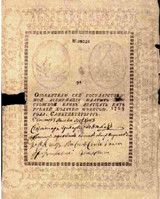
Soft money (banknotes) introduced in Russia
On December 29, 1768 (January 9, 1769) the empress Catherine II issued a manifesto on foundation of two assignat banks and banknotes issue.
The banks established in St.-Petersburg and Moscow were in charge of exchanging copper money for the state banknotes of four face values: 25, 50, 75 and 100. They were printed with black printer’s ink on white paper with filigrees. In both capitals private individuals making public payments were obliged to use minimum one banknote of 25 rubles for every 500 rubles.
The banknotes issue was justified by the fact that “the heaviness of a copper coin approving its proper value at the same time complicates its circulation”. At the time mainly was used a copper coin and in order to deliver 1000 rubles in this “currency”, weighting 62.5 poods, two carts were needed. Besides calculation of coins took a lot of time and usually entailed arithmetic mistakes. Soft money was deprived of such shortcomings.
The immediate reason for banknotes issue was the war with Turkey of 1768-1774 that needed a significant financing. According to the plan of a Senate prosecutor general, prince A. A. Vyazemsky it was suggested to issue banknotes for the sum of 2.5 million rubles backed by the base coins of 2 million rubles and thus to use 500 rubles for covering the state charges.
Since all the banknotes were originally printed on the same sheets of white paper with “Love for the fatherland” inscription at the top and “Effective for the benefit of it” at the bottom, frauds quickly started to forge 25 rubles banknotes for 75 rubles ones. Soon the issue of 25 rubles banknotes was stopped so that not to lead people into temptation. However for money falsification the death penalty was imposed, in rare cases replaced by penal servitude for life. In 1786 the assignat banks of St.-Petersburg and Moscow were transformed into the integrated state assignat bank which started to issue banknotes of a new pattern on the paper with more complicated filigrees.
Originally the banknotes became popular but their emission increase mainly due to the increase of charges for the war needs and the nobles’ ownership of land support led to their abrupt devaluation. During 27 years of her reign Catherine II had issued the banknotes for the sum of 150 million rubles but there were almost no base coins for them. Currency circulation was in disorder and resulted negatively on the entire national economy.
In 1843 started the exchange of banknotes for the bills of credit.
Lit.: Васюков А. И., Горшков В. В., Колесников В. И., Чистяков М. М. Бумажные денежные знаки России и СССР. СПб., 1993; Гусаков А. Д. Денежное обращение дореволюционной России. М., 1954; Гусаков А. Д. Очерки по денежному обращению России. М., 1946.
Based on the Presidential Library’s materials:

